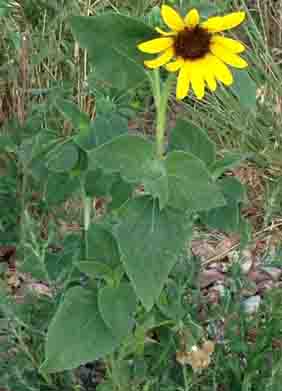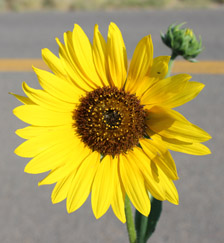 |
 |
Food:
"---sunflower seeds, so rich a source of vitamins and minerals, have been widely used by Indians since prehistoric times, parched and eaten whole or ground into flour. These seeds, put through a grinder, may be mixed with flour or cornmeal for mush, bread making or soups." (Dunmire and Tierney 226)
"Some seeds were eaten raw, but most were dried, parched, ground lightly to break their shells, and poured into a container of water, where the kernels sank and the shells floated. The shells were skimmed off, roasted, and used to make a coffee-like beverage. The kernels were eaten whole or ground into meal, which was boiled in water to make gruel or mixed with bone marrow or grease to make cakes. Small, flat sunflower-seed cakes provided light-weight, high-energy food on journeys. Crushed seeds were boiled in water, and the oil was skimmed from the surface and used like olive oil. Sunflower seed sprouts are also edible." (Kershaw 180)
Recipe 1: Raw Sunflower Seed Milk
"Collect a pint glassful of sunflower seeds. Remove the shells by gently crushing them. For assistance separating seeds from shells, soak cracked seeds in water and allow shells to float to the top. Skim shells off with a tea strainer and agitate the water, allowing more shells to be freed to float up. Once shells are removed, soak seeds in a bowl of fresh water for 8 hours. Change the water once or twice during that time.
Rinse seeds, and place in blender. Fill blender with water, and blend on high speed until water is white and milky and seeds are pulverized, about 3 minutes. Strain through a very fine sieve, making sure to collect the milk in a bowl below. Use a soft spatula to press all of the milk out. Use as a milk replacement; great with muesli or granola and dried fruit.
Store in a glass jar with a lid in the fridge for five to seven days. Save seed pulp for Sunflower Seed Granola (see recipe below). The milk will separate and needs to be shaken before each use.
Variations: Add honey for a sweeter milk. Add a few dates (pits removed) for sweetness and thickness. Substitute raw almonds for half the sunflower seeds."
Recipe 2: Sunflower Seed Granola
"Using the pulp from the milk recipe above, combine with an equal amount dry organic oats, 1/8 cup flax seeds, and 2 tablespoons soft coconut oil or butter. Mix well. Add lots of plump fat raisins; combine. Spray a cookie sheet with oil. Press mixture onto cookie sheet until about 1/4"- 3/4" thick. Bake at 225 degrees F until just beginning to brown around the edges, about 30 minutes, but this will vary depending on your oven , how thick your mixture is pressed out, and altitude. Continue baking another 5 to 8 minutes. Remove from oven and let cool. Break into pieces, and store in a glass jar with a lid. Use like cereal; serve with fresh almond or sunflower seed milk.
Variation: Dry in a food dehydrator rather than in the oven." (Morgan 44)
Medicine:
"At Jemez the stem juice of sunflowers is used for cuts, as is that of its weedy neighbor, the cocklebur. This is probably a good way to clean small wounds. At Zuni the root has been associated with treating rattlesnake bites." (Dunmire and Tierney 226)
"Common sunflower has been used to treat many ailments, including rheumatism, headaches, kidney weakness, malaria, worms, fatigue, sores, swellings, blisters and even prenatal problems believed to have been caused by an eclipse of the sun. ---Sunflower seed oil was sometimes taken to relieve coughs and laryngitis. The flowers were used to make medicinal teas for treating lung problems, and the leaf tea was given to relieve high fevers. Sunflower leaves were applied as poultices to snakebites and spider bites. To remove a wart, the wart was scratched, and the pith from a sunflower stalk was then burned on top of it." (Kershaw 180)
Other Uses:
"San Ildefonso women put the flowers on their dresses for decoration during corn dance. ---The flowers are worn in women's hair and woven into a circle to fit the hats worn by men during harvest dance.
San Juan Pueblo men once used the light, strong stems for bird snares and arrows. The stalks are easily hollowed out and made into Indian flutes." (Dunmire and Tierney 226)
"Indians also made a yellow dye by boiling the petals, and this coloration is used in basketry by the Hopi of Arizona.
In the small village of La Bajada, where this annual herb is called castillo, I was told that a bath is prepared with the green or dry leaves for rheumatism and pains in the bones." (Curtin 21)
"Oil from the seeds was rubbed on the body and used to groom hair. It has also been used in candle making and soap making. The flowers provided a superior yellow dye, and the seeds were used to make black or purple dyes. Sunflower stem fibers were made into paper." (Kershaw 180)